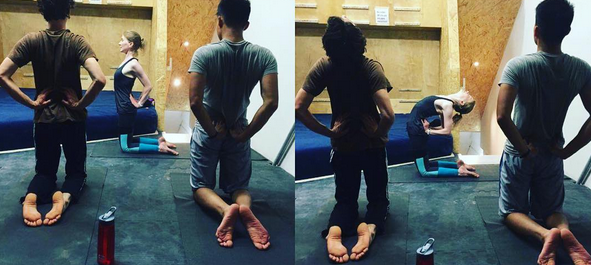 It has been nearly a month since I completed my 200hrs Yoga Teacher Training with YogaLondon (highly recommended). The first few days I was on a high – I’d just graduated and felt I was ready to launch myself into teaching. A week later I was full of doubts!
It has been nearly a month since I completed my 200hrs Yoga Teacher Training with YogaLondon (highly recommended). The first few days I was on a high – I’d just graduated and felt I was ready to launch myself into teaching. A week later I was full of doubts!
‘You’ve finished your YTT… but can you actually teach real people?’ This was what was going round and round in my head. Friends and family had become fed up of being experimented on relentlessly during my training, so any teaching practice since had involved teaching my imaginary student, using my loud teacher voice, in the living room whilst my cat was either trying to sleep on my mat or join in. I’m pretty sure the neighbours think I’m insane!
I was starting to feel quite panicky about the prospect of teaching my first class. What if I just freeze? What if I can’t remember my sequencing? What if my class is boring and my students don’t want to come back? What if? What if?
So what actually happened? Arriving I felt quite anxious but setting up the room and greeting the students I somehow lost all those fears and doubts. It was amazing, I absolutely loved teaching. I felt prepared, nothing I had predicted happened. The class went well, with a nice flow and all the students worked really hard. It wasn’t a struggle, it just felt so natural. I had managed to offer appropriate modifications and alternative asana for those with injuries,everyone was smiling. The feedback I got at the end of class was really positive, everyone said they enjoyed it and even asked if I taught other classes!I couldn’t have asked for a better experience.
5 Things about teaching my first class.
- When you are not talking, it is very silent – this can be disconcerting, but remember – when you are participating in class the silence is nice. The students like to have a bit of space and time to just be, to explore the asana and how it feels.
- If you ask a question, it’s likely no-one will say anything at first. This is okay, just carry on, they do start responding once you gain their trust!
- Don’t be afraid to challenge your students – emphasising the process of exploring where their individual challenges are and working on those. It’s the journey – not the destination.
- In savasana some people won’t close their eyes. That’s okay…it might make you feel uncomfortable, like you are being watched BUT it’s better the student feels comfortable! This is their time, you don’t want them feeling on edge! Hopefully in time they will learn to feel safe in the space and completely relax.
- My favourite moment? Bringing them out of savasana – everyone looks so peaceful. Bringing the awareness back to the body, wiggling their toes and fingers, it’s amazing to see these tiny movements as they reconnect.

So if you are prone to anxiety, like me, and you have just qualified then really don’t worry. It is completely normal to have some doubts and fears but dont let the what if’s stop you.”Paralysis by over analysis is deadly” Assuming you’ve had good quality training there really is nothing to worry about.
Good Luck – Harri x



 d Movement are in unison throughout the sequence, it’s a moving meditation, with all postures linked together by vinyasa. Mysore – A way of teaching in the traditional way, where the teacher works individually to teach the student the sequence, one asana at a time. Each person is doing their own practice within the class and will go up to where they are in the sequence and stop. Once you master a pose your teacher will give you the next.
d Movement are in unison throughout the sequence, it’s a moving meditation, with all postures linked together by vinyasa. Mysore – A way of teaching in the traditional way, where the teacher works individually to teach the student the sequence, one asana at a time. Each person is doing their own practice within the class and will go up to where they are in the sequence and stop. Once you master a pose your teacher will give you the next.